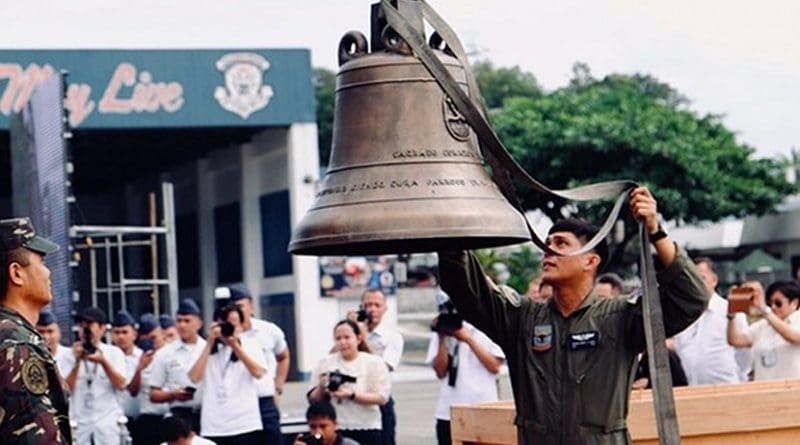Balangiga Bells Arrive Back In Philippines, Closing Bitter Chapter in US-Filipino Ties
By BenarNews
By Luis Liwanag and Jeoffrey Maitem
American and Filipino officials on Tuesday hailed a “bright future” and the end to a dark episode in their nations’ longtime alliance as the United States brought back to Philippine soil three bells looted from a local church in 1901.
After a U.S. Air Force plane carrying the Bells of Balangiga landed in Manila, the American ambassador to the Philippines signed them over to Filipino Defense Secretary Delfin Lorenzana in a ceremony filled with symbolism.
“The return of the Bells of Balangiga lets us reflect on the U.S.-Philippine relationship – where we have been, where we are, where we are going,” U.S. envoy Sung Kim said during a handover witnessed by kin of Filipinos who were killed by American forces in the sacking of Balangiga town, in the central Philippines, during the Philippine-American War 117 years ago.
American troops at the time claimed the church bells as war booty.
The bells were symbolically flown in on a U.S. military cargo plane named after late American Gen. Douglas MacArthur, who once famously declared that he would return to liberate the Philippines – a U.S. colony at the time – from Japanese occupation during World War II.
Kim said the ties binding the two allies were “ironclad” and “consecrated by the service and sacrifice of the Americans and Filipinos who fought side-by-side for freedom.”
“On behalf of the United States, it is my great honor to be here at this closing of a painful chapter in our history,” he said. “The bells’ return reflects the strong bonds and mutual respect between our nations and our people. It demonstrates our determination to honor the past and the sacrifices made together by Filipinos and Americans. And it heralds our bright future as friends, partners, and allies.”
While Kim noted that past Philippine presidents had worked to have the bells returned, President Rodrigo Duterte took the Americans to task over them.
The president’s rhetoric and threats to sideline Washington while the Philippines sought closer ties with U.S. rivals China and Russia were largely seen as having sped up legal work needed to repatriate the church bells.
“The history of these bells spans the entire relationship between the United States and the Philippines. In the process, they have touched many lives. And their return underscores the enduring friendship between our countries, our shared values and shared sacrifices,” Kim said.
The bells soon will be reinstalled at the Church of San Lorenzo de Martir in Balangiga, Samar province, a fitting Christmas gift to the mostly Catholic town that was pining for the return of the historical artifacts.
With the bells finally back on Philippine soil, both countries can now move on, Lorenzana said.
“They are going back to where they belong. It is time for healing. It is time for closure. It is time to look ahead as two nations should which shared history as allies,” the Philippine defense chief said.
“There’s no need to argue who is wrong and who is right. But it is safe to say these bells come to symbolize a painful episode in the history both the Philippines and U.S.,” he said.
Heading home
Duterte will be present during the handover of the Balangiga bells on Saturday in Eastern Samar.
In the town of Balangiga, residents were excited for the historic homecoming of the three bells, and local officials have tightened the security in time for the arrival ceremony. For the first time in more than a century, the bells will peal to mark this year’s nine dawn Masses before Christmas.
“We are praying we will have a good weather on the day of arrival,” said Fe Campanero, a town tourism officer, adding that the bells will be open for a public viewing for locals and tourists after the turnover.
The bells of Balangiga were considered war trophies by the U.S. Army after reprisals that followed the infamous Balangiga Massacre on Sept. 28, 1901. The massacre was ordered to avenge the deaths of 45 American soldiers who were attacked by Filipino guerrillas. The bells were taken by American soldiers because they were used to signal a surprise attack by Filipino revolutionaries.
After being removed from the Philippines, one of the bells wound up with the U.S. 9th Infantry regiment at Camp Red Cloud in South Korea, while the two others ended up were at F.E. Warren Air Force Base in Cheyenne, Wyo.
President Duterte used the story of the Balangiga Massacre to cast aspersions on the U.S. government after it questioned his administration’s war on drugs that has left thousands dead since mid-2016. He then demanded the return of the bells, and accused Washington of being hypocritical for calling him out on alleged rights abuses when the American military had committed past atrocities.

